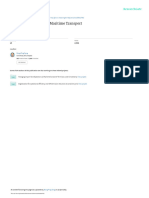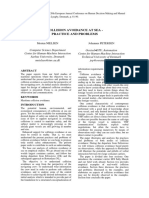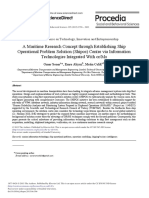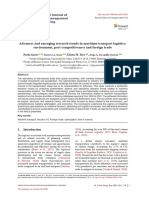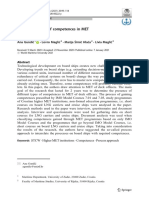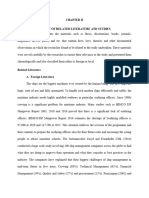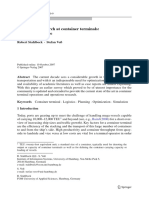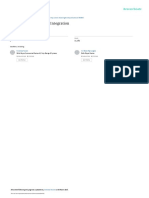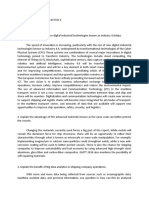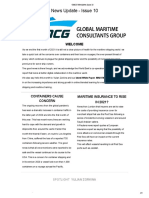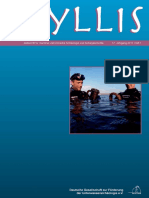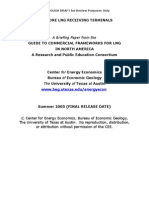Evaluating The Gap in Specialised Training For Container Ship Deck Officers: Implications For Maritime Safety
Evaluating The Gap in Specialised Training For Container Ship Deck Officers: Implications For Maritime Safety
Volume 10, Issue 3, March – 2025 International Journal of Innovative Science and Research Technology
ISSN No:-2456-2165 https://doi.org/10.38124/ijisrt/25mar1675
Evaluating the Gap in Specialised Training for
Container Ship Deck Officers: Implications for
Maritime Safety
Svilen Velinov1
1
Department of Operation and Management of Maritime Transport
Nikola Vaptsarov Naval Academy (NVNA) Varna, Bulgaria
Publication Date: 2025/04/09
Abstract: Container ships play a vital role in global trade by transporting a significant portion of general cargo worldwide.
Despite extensive safety regulations, accidents continue to occur, often due to human error and non-compliance with
mandatory cargo stowage and securing requirements. This study analyses the need for specialised training for seafarers
responsible for cargo operations on container ships to ensure compliance with International Maritime Organization (IMO)
regulations and reduce accidents. A review of statistical data on container ship accidents, a comparative analysis of training
standards for different vessel types, and an examination of current IMO regulations related to container ship crew training
were conducted. The analysis revealed that human error is the largest contributing factor to accidents, and a significant
proportion of safety recommendations are related to cargo handling and transportation. However, the STCW Code and
IMO model courses lack specialized training for container ship deck officers, in contrast to the extensive training provided
for tanker officers. A survey of nautical students who completed their first contract as junior cadets on container ships
confirmed the findings, highlighting the need for ship type-specific training. The study recommends that the IMO review
the current training standards for container ships and consider introducing type-specific training for all crew joining
container ships to address this gap and improve maritime safety.
Keywords: Container Ships; Maritime Safety; Crew Training; Specialised Training.
How to Cite: Svilen Velinov. (2025). Evaluating the Gap in Specialised Training for Container Ship Deck Officers: Implications
for Maritime Safety. International Journal of Innovative Science and Research Technology,
10(3), 2436-2443. https://doi.org/10.38124/ijisrt/25mar1675.
I. INTRODUCTION The evolution of container ships is a fundamental
aspect of maritime logistics driven by technological
Cellular container ships are essential for global trade, advances, economic requirements, and environmental
transporting over 60-70% of general cargo, including considerations, and has been characterized by the increasing
industrial goods, electronics, clothing, and food. Their size of vessels, integration of advanced technologies, and
efficiency and cost-effectiveness have revolutionized drive towards sustainable practices. The future of container
logistics and international trade. However, shipping remains shipping is likely to be shaped by these continuing trends as
a high-risk industry, with accidents continuing despite the well as by the emerging challenges and opportunities for
IMO’s (International Maritime Organisation’s) extensive shipping considered from a global perspective.
safety regulations.
The size of container ships has been steadily increasing,
Investigations by IMO committees, flag with the capacity of the largest vessels increasing from 5,500
administrations, and classification societies reveal that many TEU in 1995 to over 24,000 TEU in 2023 [1].
container ship accidents result from non-compliance with
mandatory cargo stowage and securing requirements, often The introduction of ultra-large container vessels
due to human error. Despite existing IMO instruments and (ULCV) is expected to continue, with forecasts suggesting
various studies on maritime training, there is no the development of vessels in excess of 27,000 TEU [2].
comprehensive research addressing the gaps in training that However, the economic feasibility of such large ships
contribute to human error in container ship operations. depends on market conditions including freight rates and
load factors [3].
IJISRT25MAR1675 www.ijisrt.com 2436
Volume 10, Issue 3, March – 2025 International Journal of Innovative Science and Research Technology
ISSN No:-2456-2165 https://doi.org/10.38124/ijisrt/25mar1675
The increased size of container ships has significant Unfortunately, owing to high reputational risks, accident
implications for port infrastructure, necessitating investment conditions and accidents are often concealed by companies.
in facilities to accommodate these large vessels [4]. Thus, they could not be statistically reported and analysed.
Although flag administrations are obliged to conduct such
The continuing trend of increasing ship size will investigations, they are also stakeholders, as the reported
continue to shape the shipping industry but will also require results affect their image as the body responsible for the
careful consideration of economic and operational control of ships under their flag. Statistical analyses in the
conditions to ensure long-term stability of investment. field of maritime safety are mainly conducted at the request
of international insurance companies, and the results affect
Although the evolution of container shipping has been corporate insurance policies in maritime transport. The
marked by significant progress, it faces challenges related to institutional systematic statistical analysis of maritime safety
standardization and adaptation to new technologies. The has only been introduced in recent years and is limited to
need for uniform standards in container shipping often specific shipping areas.
conflicts with the rapid pace of technological change,
creating dynamic tensions that affect the evolution of the It is common practice for parties to contracts of carriage
industry, including crew training standards. (shipowners and charterers) to resolve their disputes through
arbitration, avoiding the public interest and thus preventing
This study analyses the need for specialized independent and objective investigation and analysis of
professional training for seafarers responsible for cargo incidents with fewer consequences.
operations on container ships, ensuring compliance with
IMO regulations, and reducing accidents caused by human In 2008, the IMO Maritime Safety Committee (MSC)
error [5]. adopted a Code for the Investigation of Marine Casualties
and Incidents [6]. The relevant amendments to SOLAS
II. METHODS Chapter XI-1 were also adopted to make Parts I and II of the
Code mandatory.
This study reviews the statistical data of container ship
accidents, focusing on human error and non-compliance In order to achieve efficiency in the collection and
issues. A comparative analysis of the training standards for processing of world shipping statistics, the IMO developed
container ships and other vessel types is performed. A the Global Integrated Shipping Information System (GISIS).
regulatory review of the current IMO regulations and Its official website allows online access to information
guidelines related to container ship crew training is provided to the IMO Secretariat by maritime administrations
conducted. The need for type-specific training for deck in accordance with the IMO instruments. GISIS consists of
officers is verified by processing survey forms completed by several subsystems, including modules with different
4th year nautical students of the Nikola Vaptsarov Naval focuses, in accordance with MSC-MEPC.3/Circ.4/Rev.1 [7].
Academy (NVNA) upon returning from their first One was designed to systematize information about
employment as junior deck cadets on board container ships. maritime accidents and incidents.
The research is limited to the training requirements of A number of researchers are addressing the problem of
master and deck department officers, but the results may be improving the maritime accident analysis system, and it is
extended to other ranks, as appropriate. widely believed that there is a noticeable shortage of data on
the consequences of maritime accidents [8]. Ma and Deng
III. ANALYSES OF INCIDENTS WITH [9] develop a complex network approach to risk factor
CONTAINER SHIPS identification and find that controlling strategies can be
different depending on the situation. Fan and Yang [10]
Despite the continued efforts of all shipping developed a machine-learning model for marine accident
organisations concerned, we have witnessed container ship research in confined waters. Weng and Yang [11] applied a
accidents and incidents every year. Competent authorities statistical method to estimate worldwide marine accidents
investigate the causes of these occurrences, the analysis of and determine accident fatality rates. Maya et al [12] used a
which is used by maritime authorities to establish new safety fuzzy cognitive map to estimate the risk factors for marine
standards and to improve existing standards. Shipping accidents. Chen et al [13] used a logistic model to analyse
companies apply this knowledge to improve their total loss ship accidents and found that they were mainly due
operational safety. to sinking and collision. Gucma and Androjna [14] used a
simplified estimation framework for the assessment. Chen et
Comprehensive analysis requires a reliable and detailed al [15] conducted a systematic study of total loss marine
representation of the accident operating environment, casualties worldwide, identifying grounding and sinking as
including the participants (persons, ships, port terminals, critical risk factors, and developed a model to analyse human
operators), conditions (hydrometeorological), situation factors associated with marine casualties [16]. Yildirim and
(sequence of errors and omissions), triggering factors Bashar [17] delineated human factors influencing marine
(proximate causes), and root causes (personnel and casualties using a Human Factor Analysis and Classification
organizational factors). The IMO developed a specific System (HFACS) framework. Paolo et al [18] performed a
methodology for maritime risk assessment (FSA). similar analysis using the cluster analysis method.
IJISRT25MAR1675 www.ijisrt.com 2437
Volume 10, Issue 3, March – 2025 International Journal of Innovative Science and Research Technology
ISSN No:-2456-2165 https://doi.org/10.38124/ijisrt/25mar1675
A detailed analysis of accident rates specifically for to improve safety in cargo transportation and related
container ships [19] was carried out by the World Maritime activities. In terms of human factors, 21% of the
University (WMU), which presented in-depth statistics on recommendations were made. Nearly half of the corrective
the 445 maritime accidents involving container ships actions are related to cargo handling and transportation, crew
studied, based on data for the period 2011-2022, extracted actions, and company procedures. Hence, it can be
from the GIS Maritime Casualty and Incident (MCI) module, concluded that the current maritime training system has
supplemented mainly with EMCIP data. In addition to significant gaps in the training of container ship crews
statistics on the loss of containers at sea, the report contains regarding the performance of safe cargo transportation
information on casualties, consequences, incidents, human activities
errors, contributing factors, and safety recommendations.
The analysis methodology was based on IMO IV. INTERNATIONAL STANDARDS FOR
recommendations, according to MSC- SEAFARER TRAINING
MEPC.3/Circ.4/Rev.1.
Prior to 1978, the training and certification of seafarers
The analysis shows that the average annual loss of and other standards related to their qualifications were
containers at sea over the 15-year period from 2008 to 2022 individually regulated by all countries that had a merchant
is 1,566 units and has a steadily increasing trend in container fleet. As a result, standards vary widely, which creates a
losses at sea, although reduced losses were recorded in 2022 number of inconveniences and often leads to serious
and 2023. operational difficulties such as delays of ships in ports and
disputes between administrations over the application of
Specifically, for container ships, one-third of the standards, and has a negative impact on the overall safety of
casualties occurred in ports and their approaches (33.26%). shipping. To permanently solve this problem, the IMO
This can be explained by the dynamic working environment initiated the adoption of a specialized convention,
and higher intensity of cargo handling activities compared to International Convention on Standards of Training,
other ship types. Certification and Watchkeeping for Seafarers 1978 (STCW).
Although no official data comparing the casualty rate First established in 1978, the STCW standardized
of container ships with that of oil tankers have been educational procedures for seafarers. Since then, it has been
published, it is possible to compare the total number of the most influential normative document in maritime
recorded casualties in GISIS, taking into account the number education. The Convention and the Code (STCW Code)
of ships of the respective types. When a reference was made were amended in 1995 and 2010. These amendments were
for the period 01.01.2015 - 10.01.2025 [20], a total of 182 implemented in response to the recognized need to update
accidents with oil tankers and product carriers, and 323 with the qualification requirements for seafarers.
container ships, respectively, were recorded. At the same
time the number of registered ships was 7 323 and 6 844 As the last significant revision of the Convention was
respectively. Recalculating these figures, it appears that on made in 2010, it has been accepted that today's version
average there were 4.72 accidents per 1 000 container ships should be abbreviated as STCW 2010.
and only 2.47 accidents per 1 000 oil tankers and product
carriers (averaged) per year. This shows that the safety To achieve full implementation of the minimum global
problem of container ships is quite topical, and they are standards of competence set out in the Convention, it is
definitely not inferior in terms of the number of accidents to necessary to be familiar with the full set of rules and
other types of cargo ships, but just the opposite. While the recommendations presented in the Convention and the Code.
IMO has been actively working for decades and introducing
measures to improve the safety environment for tankers, Articles of STCW 2010 and its Annex provide a legal
container ships have remained out of focus. framework for the implementation of mandatory technical
standards. Part 'A' of the Code sets out the minimum
The WMU analysis for the period 2011-2022 shows requirements applicable to candidates for certification of
that human error is the largest contributing factor to individual competencies. To relate the provisions for
accidents, accounting for 39% of the total. Environmental alternative licencing to those for basic licencing under
impacts and equipment failures are almost equally likely, Chapters VII and II, III, and IV, respectively, the competency
with approximately 15% of cases each. Accidental events standards are divided into seven functions as follows. Three
were not identified in 43% of the cases in the database, which of them (1, 2 and 3) are related to deck department. For the
reduced the ability to draw conclusions and take corrective purpose of this study only Function 2 “Cargo handling and
action. The proportion of human errors is impressive, with stowage” has to be analysed as it is the only one related to
statistical analyses showing that they most often lead to the cargo operations.
occupational accidents and collisions.
As per STCW crew members are divided into three
From the point of view of introducing future corrective levels of responsibility depending on the position they hold
measures, statistics on the distribution of the "focus areas" of on board: Management level, Operational level, and Support
the prescribed safety recommendations are very important. level. The so-called "top four" (master, chief mate, chief
The largest number of recommendations (28%) were made engineer officer and second engineer officer) are assigned to
IJISRT25MAR1675 www.ijisrt.com 2438
Volume 10, Issue 3, March – 2025 International Journal of Innovative Science and Research Technology
ISSN No:-2456-2165 https://doi.org/10.38124/ijisrt/25mar1675
the management level. The remaining officers are considered Function 2 for OOWs includes two competencies. The
to be operational level and the executive staff are support first is related to the knowledge required by deck officers to
level. successfully supervise cargo handling operations and to take
due care of cargo during voyage. The overall definitions of
Chapters II, III, and IV of Part A of the Code set out the knowledge and skills in column 2 are also very general.
standards of competence in a convenient tabular format There are no IMO instruments references. The only type of
while specifying the levels of responsibility and functions. cargo mentioned are the heavy lifts and their effect on the
seaworthiness of the ship and the dangerous and hazardous
For the purpose of this study, it is necessary to analyse cargoes. Apparently, the IMO does not consider it necessary
the training requirements for deck officers at the to regulate specific mandatory topics concerning rules for the
management and operational levels for Function 2 ("Cargo safe handling of different types of cargo. This gives the
handling and stowage"). The other two functions applicable impression that OOWs can be trained in a methodology that
to ship officers will not be examined in detail, as the training provides them with general knowledge of the principles of
subject matter covered by them is applicable irrespective of ensuring the seaworthiness of the ship and preventing
ship type. accidents, without going into specifics on how exactly to
achieve this for different types of ships. The second
A. Training Standards Under the STCW Code competence for OOWs addresses their ability to inspect and
All tables of minimum competence standards in the report defects and damage to cargo spaces, hatch covers and
Code are structured uniformly in four columns with the ballast tanks. This function has been introduced for the
following contents: purpose of bulk carrier crew inspections under the 2011 ESP
Code [21].
Column 1 "Competence";
Column 2 "Knowledge, understanding and proficiency"; The approach taken in Table A-II/2, related to the
Column 3 “Methods for demonstrating competence”; management level, is quite different. Here, there are three
competencies (Table 1), with masters and chief mates
Column 4 “Criteria for evaluating competence”.
required not only to report observed hull damage, but also to
be able to independently assess its severity and take
It is not necessary to consider text in Columns 3 and 4 appropriate action. In addition, the knowledge regarding
in this analysis because they are relevant only to the handling of hazardous and noxious cargoes is brought out as
assessment methodology and not to the content of the a separate competency.
Syllabus. The tables themselves are conveniently divided by
function, which allows the content of Function 2 to be
selected and analysed separately and independently of the
others.
The minimum competency standards for officer in
charge of a navigational watch (OOW) on ships of 500 GT
and more are listed in Table A-II/1.
Table 1: STCW Code A-II/2 - Knowledge, Understanding and Proficiency Applicability
Competence Knowledge, understanding and proficiency Applicable to
Knowledge of and ability to apply relevant intcrnational regulations, codes and standards
All Ships
concerning the safe handling, slowage, securing and transportation of cargoes
Knowledge of the effect on trim and stability of cargoes and cargo operations All Ships
Use of stability and trim diagrams and stress-calculating equipment, including ADB
equipment, and knowledge of loading cargores and ballasting in order to keep hull stress All Ships
within acceptable limits
Plan and ensure Stowage and securing of cargoes on board ships, including cargo-handling gear and
General Cargo Ships
safe loading, securing and lashing equipment.
stowage, securing, Loading and unloading operations, with special regard to the the transportation of cargoes
care during the General Cargo Ships
identified in the CSS Code.
voyage and General knowledge on tankers and tanker operations Tankers
unloading of
Knowledge of the operational and design limitations of bulk carrierrs Bulk carriers
cargoes
Ability to use all available shipboard data related to loading, care and unloading of bulk
Bulk carriers
cargoes
Ability to establish procedures for safe cargo handling in accordance with the provisions
General Cargo Ships
of the relevant instruments, such as IMDG Code, IMSBC Code, MARPOL 73/78 Annexes
Bulk Carriers
III and V and other relevant information
Ability to explain the basic principles for establishing effective communications and
All Ships
improving working relationship between ship and terminal representative
Assess reported
defects and damage Knowledge of the limitations on strength of the vital constructional parts of a standard
Bulk carriers
to cargo spaces, bulk carrier and ability to interpret given figures for bending moments and shear forces
hatch covers and
ballast tanks and Ability to explain how to avoid the detrimental effects on bulk carriers of corrosion,
take appropriate Bulk carriers
fatigue and inadequate cargo handling
action
International regulations, standards, codes and recommendations on the carriage of General Cargo Ships
Carriage of dangerous cargoes, including the IMDG Code and the IMSBC Code Bulk Carriers
dangerous goods Carriage of dangerous goods, hazardous and harmful cargoes; precautions during loading General Cargo Ships
and unloading and care during the voyage Bulk Carriers
IJISRT25MAR1675 www.ijisrt.com 2439
Volume 10, Issue 3, March – 2025 International Journal of Innovative Science and Research Technology
ISSN No:-2456-2165 https://doi.org/10.38124/ijisrt/25mar1675
Unlike the approach taken in compiling Table A-II/1 ships or Ro-Ro ships. In the context of the statistics
mentioned above, details for the required knowledge and presented in Section III on the composition of the world
skills here is much more detailed, with a number of IMO fleet, the role of container shipping in global trade, the
instruments mentioned. As the Syllabus Outline in A-II/2 is casualty rate of container ships the absence of any
much more specified, we can examine the applicability of specialised topics related to container ships is puzzling. In
individual knowledge and skills to different ship types, this regard, it is particularly important to note that although
which is shown in the third column of Table 1. container ships are classified within the wider family of
general cargo ships, the handling technology and methods of
Fig. 1 illustrates how many of the thematic knowledge cargo securing, planning, and control of cargo operations
and skills set by the IMO for the management level are differ significantly from those of the classic general cargo
applicable to individual ship types. If a topic is intended for ships and their modern modification - the multipurpose
more than one ship type, it is reported for each ship ships.
separately, except for all ships, which are mentioned
cumulatively. Only the main types of cargo ships are Fig. 1, also shows that only one specialised tanker topic
mentioned. It is understandable that pure passenger ships are is included in the management-level syllabus of Function 2.
not covered by any of the requirements of Function 2. This seems strange on the face of it, given the risks
associated with operating this type of ships. However, the
Four of the fourteen topics are applicable to all types of IMO has adopted a different approach to ensure that tanker
ships. The number of topics related to bulk carriers is crews are sufficiently trained.
particularly large. It is followed by general cargo ships and
tankers. There is no single specialised topic on container
Fig 1: Number of Topics from the Syllabus Outline Applicable to Different Types of Ship
Part A of the Code includes Chapter V, which deals with In addition to the training standards set out so far,
so-called "special training" for crews on certain types of seafarers also undergo what is known as "additional
ships. Crews of the following types of ships are subject to training". The knowledge and skills included depend on the
such training. position held on board and the type of ship. The training
includes training for emergency situations such as fire,
oil tankers – tables A-V/1-1-1 and A-V/1-1-2; abandon ship, survival at sea, lifeboat management, first aid,
chemical tankers – tables A-V/1-1-1 and A-V/1-1-3; medical care, security duties, etc. Additional training is
gas carriers – tables A-V/1-2-1 and A-V/1-2-2; provided for passenger and Ro-Ro passenger ship crews. All
passenger ships – A-V/2, A-V/2-1 and A-V/2-2; crew members should be given knowledge of maintaining
ships subject to the IGF Code [22] – tables A-V/3-1 and safety on board, with training at levels depending on the
A-V/1-2; position on board.
ships operating in polar waters – tables А-V/4-1 and А-
V/4-2. Fig. 2 shows a summary table of the specific
knowledge and skills required in the training of deck officers
Special training is compulsory for all crew members on on different types of ships, considering the three streams of
tankers, passenger ships and those subject to the IGF Code, training: main competence, special training, and the
in accordance with their position. For ships operating in additional training. For each type of ship, it is determined if
polar waters, only deck officers are covered by the special there is a topic in the respective training specifically aimed
training requirements. at the particularities of its operation.
IJISRT25MAR1675 www.ijisrt.com 2440
Volume 10, Issue 3, March – 2025 International Journal of Innovative Science and Research Technology
ISSN No:-2456-2165 https://doi.org/10.38124/ijisrt/25mar1675
The IMO has not made any provision for deck officers ships, the standardized one is applied. General cargo ships
to undergo type-specific training if employed on container use the non-standardized system. The stowage and securing
ships and Ro-Ro vessels, although for both types of ships the methodology for this type of cargo is well developed in CSS
cargo handling technology is strictly individual and does not Code Annex 13. In contrast, there are practically no specific
coincide with that for general cargo. According to the CSS lashing methods provided in the Code for cellular container
Code, in Ro-Ro ships the cargo is stowed and secured using ships, for which they rely solely on the rules of the
a semi-standardized securing system. For cellular container classification societies approved by the administrations.
Additional
Section A-II/2 Special
Ship type training
Requirements Training
Section A-VI
General cargo ship √
Tanker √ √
Bulk carrier √
Container ship
Ro-Ro ship
Passenger ship √
Ro-Ro passenger ship √
Fig 2: Summarized Ship Specific Training Requirements for Deck Officers as per STCW 2010 Code
B. IMO Model Courses 7.01 and 7.03 - Applicability to accounting the main competence training and the special
Container Ships training.
Since the adoption of STCW 78, several IMO member
governments have advocated for model training courses to This discrepancy likely stems from the reactive nature
enhance the implementation of the STCW and facilitate the of training updates, often influenced by major incidents or
transfer of knowledge on new maritime technologies. These external pressures. The absence of container safety topics in
courses aim to harmonize global training standards, serving STCW training, alongside similar gaps for Ro-Ro ships,
as a flexible guide rather than a strict curriculum. Training highlights the need for a comprehensive revision of ship-
institutions can adapt them to their needs while ensuring type-specific education standards.
compliance with STCW standards. Model courses are
periodically updated alongside STCW amendments, with V. CONCLUSION, VALIDATION AND
state administrations responsible for overseeing compliance. RECOMMENDATIONS
For container ship deck officers, IMO does not provide This study analysed the need for specialized
dedicated training beyond general model courses. The professional training for seafarers responsible for cargo
relevant courses, 7.01 (for masters and chief mates) [23] and operations on container ships to ensure compliance with
7.03 (for watch officers) [24], were last updated in 2014 to IMO regulations and reduce accidents caused by human
align with STCW 2010. However, an analysis of their error. Despite the importance of container ships in global
content reveals significant gaps in container ship specific trade, investigations revealed that many accidents resulting
training. from non-compliance with mandatory cargo stowage and
securing requirements, often due to human error. The study
Model Course 7.03 covers cargo handling and stowage reviewed statistical data on container ship accidents,
at the operational level, including ship stability, cargo compared training standards for different vessel types, and
securing, and various cargo types. However, container ships examined current IMO regulations related to container ship
specific training is limited to two lessons (two hours), crew training. The analysis shows that human error is the
covering topics like vessel layout, slot numbering, largest contributing factor to accidents, and a significant
loading/unloading practices and securing methods. Given proportion of safety recommendations are related to cargo
the complexity of container operations, this time allocation handling and transportation. However, the STCW Code and
is quite insufficient. IMO model courses lack specialized training for container
ship deck officers, in contrast to the extensive training
Model Course 7.01, intended for management-level provided for tanker officers. The study highlights the need
officers, dedicates 139 hours to cargo operations but again for a comprehensive revision of ship-type-specific education
lacks a specialized focus on container ships. Instead, it standards to address this gap in container ship crew training.
includes 16 hours on tanker-specific topics, despite officers
already undergoing extensive tanker training in previous To verify the findings of this study, a survey was
courses. This results in an imbalance where container ship conducted among 4th year students at the NVNA who spent
officers receive minimal specialized training, while tanker their first contract as junior cadets on board container ships.
officers undergo over 116 hours of targeted training
IJISRT25MAR1675 www.ijisrt.com 2441
Volume 10, Issue 3, March – 2025 International Journal of Innovative Science and Research Technology
ISSN No:-2456-2165 https://doi.org/10.38124/ijisrt/25mar1675
They were asked the following question: “Do you European Corridors, vol. 11, I. M. Lami, Ed., in SxI
consider that ship type-specific training for container ships - Springer for Innovation / SxI - Springer per
could have helped you to better adapt to the working l’Innovazione, vol. 11. , Cham: Springer International
environment on board and would have contributed to your Publishing, 2014, pp. 33–43. doi: 10.1007/978-3-
overall safety when joining vessel?”. 319-04786-7_3.
[6]. International Maritime Organization, Ed., Casualty
The students were given the opportunity to answer on investigation code: code of international standards
a 5-point scale: 1. Very useful; 2. Moderately useful; 3. and recommended practices for a safety investigation
Neutral; 4. Not very useful; 5. Not useful at all. Totally 53 into a marine casualty or marine incident, 2008 ed.
students completed the survey. Most of them (51 %) gave in IMO publication. London: IMO, 2008.
answer 1 - “very useful” and 34% answered with [7]. IMO, “Revised harmonized reporting procedures –
“moderately useful”. Reports required under SOLAS regulations I/21 and
XI-1/6, and MARPOL, articles 8 and 12.”
The survey results confirm the findings of this study International Maritime Organization, 2014. [Online].
and raise an important issue. Cadets that joined container Available:
vessels for the first time missed ship type-specific training https://wwwcdn.imo.org/localresources/en/OurWork
for container ship cargo operations. This observation can be /MSAS/Documents/MSC-MEPC3/MSC-MEPC.3-
extended to other ranks that join container ships for the first Circ.4%20Rev%201%20%20Revised%20harmonize
time. Taking into account the opinion of the students the d%20reporting%20procedures%20-
NVNA has provided in its curriculum of Cargo Handling and %20Reports%20required%20under%20SOLAS%20
Stowage 8 academic hours of specialized classes for regulations%20I21.pdf
container ships. Unfortunately, these curriculum topics are [8]. B. Li, J. Lu, H. Lu, and J. Li, “Predicting maritime
taught to students in their final year and they can only benefit accident consequence scenarios for emergency
from this knowledge during their second contract as senior response decisions using optimization-based decision
cadets. tree approach,” Maritime Policy & Management, vol.
50, no. 1, pp. 19–41, Jan. 2023, doi:
In conclusion, it may be recommended for the IMO to 10.1080/03088839.2021.1959074.
review the current training standards for container ships and [9]. X. Ma, W. Deng, W. Qiao, and H. Lan, “A
consider the introduction of type-specific training for all methodology to quantify the risk propagation of
crew-joining container ships, not just deck officers. Training hazardous events for ship grounding accidents based
standards may include competency levels similar to the on directed CN,” Reliability Engineering & System
current tanker special training included in A-V/1 - Basic Safety, vol. 221, p. 108334, May 2022, doi:
Training (for all crew) and Advanced Training for Cargo 10.1016/j.ress.2022.108334.
Operations (for master and responsible officers). [10]. S. Fan, Z. Yang, J. Wang, and J. Marsland, “Shipping
accident analysis in restricted waters: Lesson from
REFERENCES the Suez Canal blockage in 2021,” Ocean
Engineering, vol. 266, p. 113119, Dec. 2022, doi:
[1]. Raunek, “Top 22 World’s Biggest And Largest 10.1016/j.oceaneng.2022.113119.
Container Ships in 2024,” Marine Insight, 2024, [11]. J. Weng and D. Yang, “Investigation of shipping
[Online]. Available: https://www.marineinsight.com accident injury severity and mortality,” Accident
/know-more/top-10-worlds-largest-container-ships- Analysis & Prevention, vol. 76, pp. 92–101, Mar.
in-2019/ 2015, doi: 10.1016/j.aap.2015.01.002.
[2]. Chen Yang, “27500 TEU!! Here comes the world’s [12]. B. Navas De Maya and R. E. Kurt, “Marine Accident
largest container ship!,” Xinde Marine News. Learning with Fuzzy Cognitive Maps (MALFCMs):
[Online]. Available: https://www.xindemarinenews. A case study on bulk carrier’s accident contributors,”
com/m/view.php?aid=56265 Ocean Engineering, vol. 208, p. 107197, Jul. 2020,
[3]. J. Ge, M. Zhu, M. Sha, T. Notteboom, W. Shi, and X. doi: 10.1016/j.oceaneng.2020.107197.
Wang, “Towards 25,000 TEU vessels? A [13]. J. Chen, W. Bian, Z. Wan, S. Wang, H. Zheng, and
comparative economic analysis of ultra-large C. Cheng, “Factor assessment of marine casualties
containership sizes under different market and caused by total loss,” International Journal of
operational conditions,” Marit Econ Logist, vol. 23, Disaster Risk Reduction, vol. 47, p. 101560, Aug.
no. 4, pp. 587–614, Dec. 2021, doi: 10.1057/s41278- 2020, doi: 10.1016/j.ijdrr.2020.101560.
019-00136-4. [14]. L. Gucma, A. Androjna, K. Łazuga, P. Vidmar, and
[4]. R. J. Sánchez, D. E. Perrotti, and A. G. P. Fort, M. Perkovič, “Reconstructing Maritime Incidents and
“Looking into the future ten years later: big full Accidents Using Causal Models for Safety
containerships and their arrival to south American Improvement: Based on a Case Study,” JMSE, vol. 9,
ports,” J. shipp. trd., vol. 6, no. 1, p. 2, Dec. 2021, no. 12, p. 1414, Dec. 2021, doi:
doi: 10.1186/s41072-021-00083-5. 10.3390/jmse9121414.
[5]. B. Musso, “The Evolution of Maritime Container [15]. J. Chen, W. Bian, Z. Wan, Z. Yang, H. Zheng, and P.
Transportation,” in Analytical Decision-Making Wang, “Identifying factors influencing total-loss
Methods for Evaluating Sustainable Transport in marine accidents in the world: Analysis and
IJISRT25MAR1675 www.ijisrt.com 2442
Volume 10, Issue 3, March – 2025 International Journal of Innovative Science and Research Technology
ISSN No:-2456-2165 https://doi.org/10.38124/ijisrt/25mar1675
evaluation based on ship types and sea regions,”
Ocean Engineering, vol. 191, p. 106495, Nov. 2019,
doi: 10.1016/j.oceaneng.2019.106495.
[16]. D. Chen, Y. Pei, and Q. Xia, “Research on human
factors cause chain of ship accidents based on
multidimensional association rules,” Ocean
Engineering, vol. 218, p. 107717, Dec. 2020, doi:
10.1016/j.oceaneng.2020.107717.
[17]. U. Yıldırım, E. Başar, and Ö. Uğurlu, “Assessment of
collisions and grounding accidents with human
factors analysis and classification system (HFACS)
and statistical methods,” Safety Science, vol. 119, pp.
412–425, Nov. 2019, doi:
10.1016/j.ssci.2017.09.022.
[18]. F. Paolo et al., “Investigating the Role of the Human
Element in Maritime Accidents using Semi-
Supervised Hierarchical Methods,” Transportation
Research Procedia, vol. 52, pp. 252–259, 2021, doi:
10.1016/j.trpro.2021.01.029.
[19]. Anish Hebbar, Clever Tugume, and Jens-Uwe
Schroeder-Hinrichs, “A statistical overview of
containerships casualties.” World Maritime
University, 2024. [Online]. Available: https://docs.
imo.org/Shared/Download.aspx?did=150891
[20]. IMO GISIS, “GISIS: Marine Casualties and Incidents
2015-2025.” 2025. [Online]. Available: https://
gisis.imo.org/Members/MCIR/Search.aspx
[21]. IMO, Ed., International code on the enhanced
programme of inspections during surveys of bulk
carriers and oil tankers, 2011: 2011 ESP code,
Fourth edition, 2020 edition. in IMO publication.
London: IMO, 2020.
[22]. IMO, IGF Code: international code of safety for
ships using gases or other low-flashpoint fuels, 2016
edition. in IMO publication. London: International
Maritime Organization, 2016.
[23]. IMO, Master and chief mate, Rev. ed. 2014. in Model
course, no. 7.01. London: IMO, 2014.
[24]. IMO, Ed., Officer in charge of a navigational watch,
2014 ed., rev. Ed. in Model course, no. 7.03. London:
IMO, 2014.

